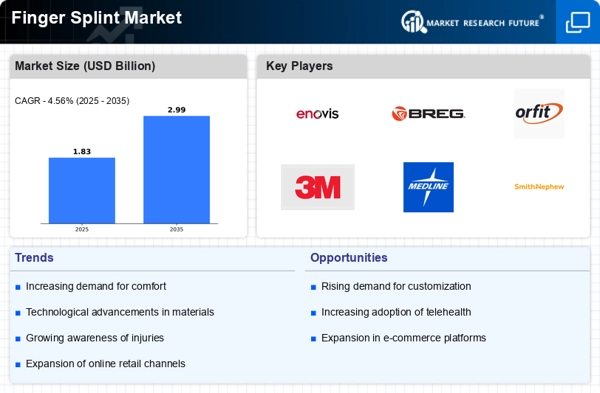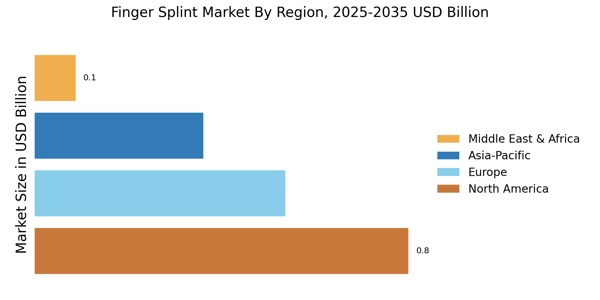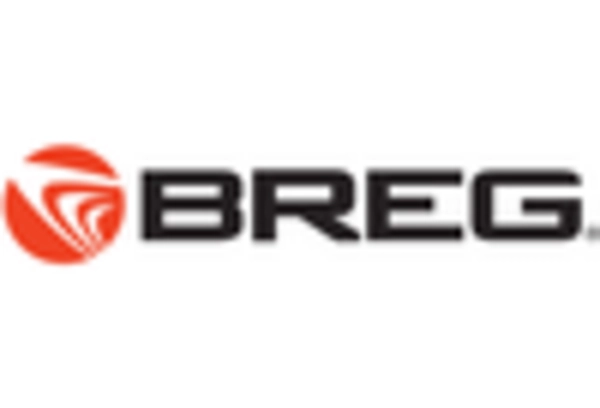Growing Aging Population
The demographic shift towards an aging population is another significant factor influencing the Finger Splint Market. As individuals age, they often experience a higher incidence of conditions such as arthritis and other musculoskeletal disorders, which can lead to the need for finger splints. Data suggests that the global population aged 65 and older is projected to double by 2050, indicating a substantial market potential for products catering to this demographic. The demand for finger splints is likely to increase as older adults seek solutions to maintain their independence and quality of life. Additionally, healthcare systems are increasingly focusing on providing supportive care for the elderly, further driving the growth of the Finger Splint Market. This trend underscores the importance of developing innovative splint designs that cater specifically to the needs of older patients.
Expansion of E-commerce Platforms
The expansion of e-commerce platforms is significantly impacting the Finger Splint Market. With the increasing reliance on online shopping, consumers are more inclined to purchase medical supplies, including finger splints, through digital channels. This trend is particularly evident among younger demographics who prefer the convenience of online shopping. Market data reveals that e-commerce sales of healthcare products have surged, indicating a shift in consumer behavior. As a result, manufacturers and retailers are focusing on enhancing their online presence to capture this growing market segment. The Finger Splint Market is likely to benefit from this trend, as e-commerce provides a platform for greater product visibility and accessibility. Additionally, the ability to offer detailed product information and customer reviews online can aid consumers in making informed purchasing decisions.
Increasing Incidence of Hand Injuries
The rising incidence of hand injuries, particularly among athletes and manual laborers, appears to be a primary driver for the Finger Splint Market. Statistics indicate that hand injuries account for a significant percentage of workplace injuries, leading to a heightened demand for effective treatment solutions. As awareness of the importance of proper hand care grows, more individuals are seeking finger splints to aid in recovery. This trend is likely to continue, as the need for rehabilitation products becomes more pronounced. Furthermore, the increasing participation in sports and physical activities contributes to the prevalence of hand injuries, thereby expanding the market for finger splints. The Finger Splint Market is thus positioned to benefit from this upward trend, as healthcare providers and consumers alike recognize the necessity of these devices in injury management.
Rising Awareness of Preventive Healthcare
The growing awareness of preventive healthcare is driving the Finger Splint Market. As individuals become more conscious of the importance of injury prevention, there is an increasing demand for products that can help mitigate the risk of hand injuries. Educational campaigns and health initiatives are promoting the use of finger splints not only for rehabilitation but also as a preventive measure. This shift in perspective is likely to lead to a broader acceptance of finger splints among various demographics, including athletes and those engaged in high-risk occupations. Market Research Future indicates that the preventive healthcare segment is expanding, suggesting a promising future for the Finger Splint Market. Manufacturers are encouraged to develop marketing strategies that emphasize the benefits of finger splints in injury prevention, thereby tapping into this growing consumer awareness.
Technological Innovations in Product Design
Technological advancements in product design are reshaping the Finger Splint Market. Innovations such as 3D printing and the use of lightweight, breathable materials are enhancing the functionality and comfort of finger splints. These developments not only improve the user experience but also expand the range of applications for finger splints, making them more appealing to a broader audience. Market data indicates that the introduction of customizable splints, which can be tailored to individual needs, is gaining traction. This trend is likely to attract both healthcare professionals and consumers, as personalized solutions become increasingly sought after. The Finger Splint Market stands to benefit from these technological innovations, as they enable manufacturers to create products that meet the evolving demands of users.


















Leave a Comment